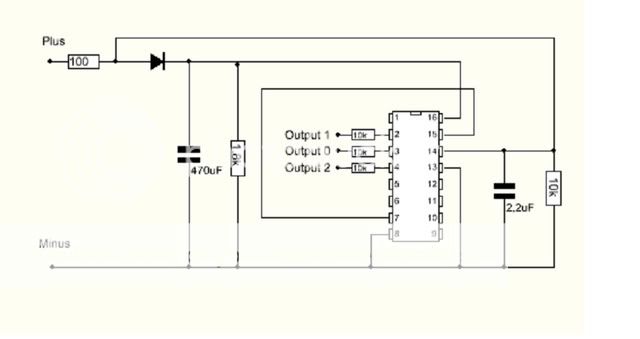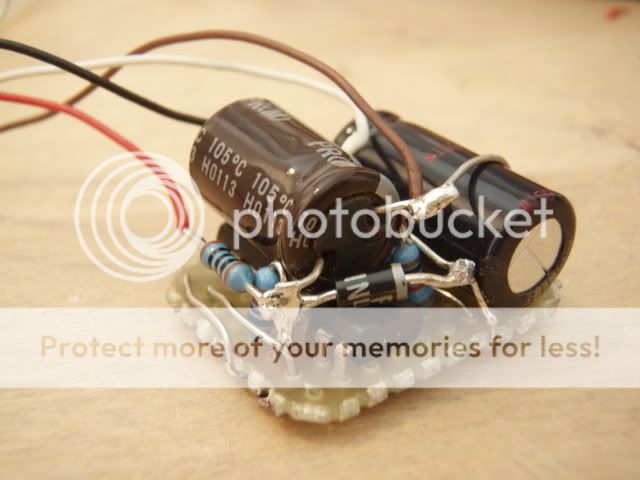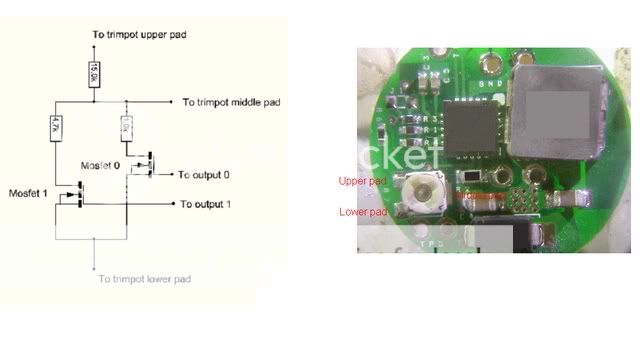Nereus
Enlightened
When I built my second magseoul mod I designed a circuit that transforms standard D mag switch to a 3-stage switch: the brightness levels are controlled with the original mag switch by turning the flashlight on and off:
*Turn the flashlight on -> it starts on low level.
*Turn the flashlight off and quickly on -> mid level.
*Turn the flashlight off and quickly on again -> high level.
*Turning the flashlight off and on one more time will start the sequence from the beginning (low).
* Keeping the flashlight off for more than 3 seconds in any stage of the sequence will zero the circuit and start the sequence from the beginning.
I used 4017 decade counter IC (see useful info here) with a few auxilary components. Here is the schematics of the control circuit:

The 4017 decade counter has ten separate outputs (0-9) which go high in sequence when the power to the clock pin (=pin #14) is pulsed. In my circuit I use only three first outputs, 0, 1 and 2. I have connected 3rd output (=pin #7) to the reset (=pin #15). As a result, when the flashlight is turned on for the fourth time, 3rd output pulls the reset pin up and the IC will immediatly start the sequence from the beginning (output pin 0 goes high). There are 10 output pins in 4017 so up to ten brightness levels can be created.
The 470 uF + 1,8 kOhm RC network keeps the IC alive for 3 seconds after turning the power off. Longer off-state will make the IC "forget" its previous on-state and starts the sequence from the beginning. 2,2 uF + 10 kOhm RC network prevents on/off transient voltage spikes from acting as pulses to the clock pin.
In my magseoul mod I removed the trimpot of the Shark and replaced it with two voltage dividers connected to two n-type mosfets. Then I used this circuit to drive the gates of the mosfets. This is what the circuit looks like:

Not very beautiful... but it fits nicely in a Mag D tube and works great!
-N
*Turn the flashlight on -> it starts on low level.
*Turn the flashlight off and quickly on -> mid level.
*Turn the flashlight off and quickly on again -> high level.
*Turning the flashlight off and on one more time will start the sequence from the beginning (low).
* Keeping the flashlight off for more than 3 seconds in any stage of the sequence will zero the circuit and start the sequence from the beginning.
I used 4017 decade counter IC (see useful info here) with a few auxilary components. Here is the schematics of the control circuit:

The 4017 decade counter has ten separate outputs (0-9) which go high in sequence when the power to the clock pin (=pin #14) is pulsed. In my circuit I use only three first outputs, 0, 1 and 2. I have connected 3rd output (=pin #7) to the reset (=pin #15). As a result, when the flashlight is turned on for the fourth time, 3rd output pulls the reset pin up and the IC will immediatly start the sequence from the beginning (output pin 0 goes high). There are 10 output pins in 4017 so up to ten brightness levels can be created.
The 470 uF + 1,8 kOhm RC network keeps the IC alive for 3 seconds after turning the power off. Longer off-state will make the IC "forget" its previous on-state and starts the sequence from the beginning. 2,2 uF + 10 kOhm RC network prevents on/off transient voltage spikes from acting as pulses to the clock pin.
In my magseoul mod I removed the trimpot of the Shark and replaced it with two voltage dividers connected to two n-type mosfets. Then I used this circuit to drive the gates of the mosfets. This is what the circuit looks like:

Not very beautiful... but it fits nicely in a Mag D tube and works great!
-N
Last edited:


